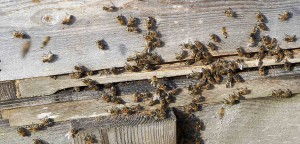The second Sunday in March the temperature, wind and sun, together with filled intestines of the bees that had produced the heat for the winter cluster took these bees out to meet the sun. The main cleansing flight took place. What a relief!
Most often in Sweden you reach well into March before the main cleansing flight takes place. Now the colony has been brooding for some time, and this accelerates now. If the colonies started to make brood too early, for example due to a warm spell in January, or if you have Italians that have a hard times taking a break in brooding, this last winter was hard at them as winter never really came until February for two weeks. Those colonies have produced many Varroa and filled their intestines early because they have used a lot of food. The immune system is thus weak. Virus, Nosema and chemical residues contribute to the risk of defecating inside the hive, if there are bees left there. Many may already have left just flying out away from the hive (due to virus) leaving it sometimes empty of bees.
This winter should have been easy for the bees due to its mildness. But for many beekeepers that have trusted oxalic acid in late autumn and drone brood cutting in beginning of season (and just that) to fight the mite, this winter has been a bad experience. For a couple of years this concept may have worked okey. And the beekeepers, perhaps beginners, have thought they are safe.
But last year the longer brood season together with no or little checking of the mite population in July/August (mite population should not be too high then when the winter bees are produced), the mite population was too high when oxalic acid treatment came in October. The weakened bees then were still more weakened by the acid and overwintering became still harder. And it became even harder as the bees still had brood when the oxalic were used. Most mites were in that brood (that of course had well developed virus population by now) and escaped the oxalic. So it’s easy to explain the winter losses of such hives.
Now a beekeeper named Bengt Haglund just north of Stockholm have used thymol gel (Apiguard) with 25 grams of thymol in the gel in one small tray in spring. Upside down directly on the top bars, just above the brood. Next treatment was directly after late summer harvest. Another tray of Apiguard with the opening upward this time, between the two brood boxes. Winterlosses for five years in average 1 % for Bengt.
My goal is treatment free. I’m close. To get there I have chosen to use small cells, breed for resistance and use good quality natural food as much as possible. On my way to this goal I made the conclusion that I was about to loose almost all my colonies when the Varroa arrived. Therefore I treated, reluctantly, and lost “only” 50 %. The only season I have lost that much, in 2008-09.
So I used Thymol. But I don’t use anything until I see wingless bees. The virus causing it is the most common associated with Varroa mites. And I use as little as possible. I’ve found a piece of dishcloth with 4 grams of soaked in thymol is enough to start with, on top of the top bars close to the brood. Every ten days another piece as long as I see crippled wings. Strong hives might get two pieces at a time. Most hives get it in spring and later just after harvest. If there is some smelling left in the boxes when I harvest, it stays in the wax actually, and in the woodenware. The honey does not get any extra flavor (if it should it’s not unhealthy at all). Thymol residues are finally ventilated away.
Yes, Thymol kills microbes. But sometimes it’s better to have dead microbes and live bees, than dead bees and with them dead microbes. And Thymol is much less dangerous for me than oxalic acid – when making the oxalic solution, when handling it, when handling eventual fumigation and when handling equipment with crystals when cleaning up dead colonies.
But again, the goal is treatment free. And I’m almost there. Last year many colonies didn’t need any Thymol. Many got only 4 grams. Another lot 8 grams, and 12, and 16. A few more, and up to 40 grams at the most. Those that got 16 and more will have their queens shifted this year.
Winter losses for me up till now is about 5 %. Still some more % will not make it until May I’m sure.
Most colonies look very fine. And it seems I have several fine breeders to use. I’m happy the investment in breeding for resistance pays.
